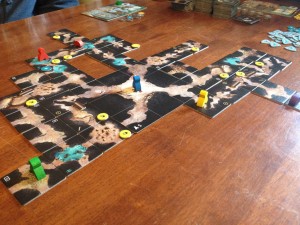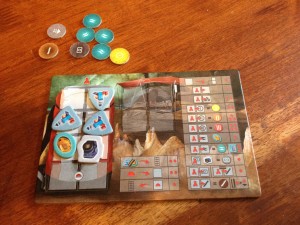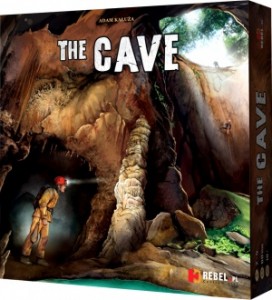Review: The Cave
Posted by James (admin) on June 1st, 2013

The Cave is by the same designer who created the mountain climbing game, K2. This time players are trying to get the most victory points (VPs) by exploring the depths of an underground cave system, taking the best photos, reaching the deepest depths, and so on. However, players have a very limited amount of space to carry their equipment like rope, food, water, etc. and must balance what they need for survival and what they need to explore.
All players start at home base and each player has a player board showing the 8 spaces in their backpack where they place the tokens representing the equipment they are carrying. One of the most important items to carry are consumables (food/drink) because a player must first discard one of their consumables before they do anything else on their turn. If a player doesn’t have any consumables then they must spend their entire turn moving one tile and can do nothing else and can gain no VPs. So, miscalculating how long you can stay in the caves before going back to resupply can really hinder you.
The cave system starts with the large home base cave tile in the centre of the table and the cave network will be created as players explore by drawing and adding new tiles. When the tiles run out, players each get 3 more turns and then the game ends; however, be warned, anyone not back at base camp by the end is automatically eliminated.
Each turn, a player gets 5 action points (APs) to spend. A player on a tile with an unexplored exit can spend 1 AP to draw a tile from the current stack and place it so adjacent sides match (tunnel-to-tunnel and rock-to-rock). If it can’t be placed, that route is permanently blocked.

My backpack with some consumables, a raft and a camera. Later on, I left my camera in my tent so I could carry an extra sandwich only to find I needed it when I was miles away.
If a new tile has a special feature on it (lake, photo opportunity, tight squeeze, or descent) then a matching exploration token is placed on it. The first player to explore this area appropriately takes the exploration token which score VPs at game end (most tokens score 2-3 VPs). Exploration tokens are individually worth VPs; however, there are lots of bonus VPs for having the most (and second most) tokens of each type.
Moving to an adjacent tile costs 1 AP but may cost more. For example, tight squeezes cost 1-3 extra APs. Some cave tiles are deeper than the previous one. If no-one has been that way before, you must spend 1 AP for each length of rope you use from your backpack. Once deployed, the rope remains for anyone to use. Laying rope earns you traverse exploration tokens, plus players score VPs based on the lowest depth they reached during the game.
Lake tiles require you to have a raft in your backpack, or to use oxygen to swim across (and swimming lets you take a water exploration token, if present). You can take the photo exploration token on a photo opportunity tile if you have a camera with you and spend 1 AP.
Players can spend APs to fill their backpack with more equipment at home base. Also, players can carry a tent which takes up a lot of backpack room but can have equipment inside it and allows the player to have a camp in which to store things in the cave network.
 Overall, The Cave is a game of careful inventory and time management as much as it is about exploration. Running out of consumables is an ever-present concern and only being able to move 1 tile each turn if you do run out (as you crawl on your face back to home base) is a massive penalty that makes you take your equipment load seriously. Also, it is critical to manage the balance in your pack between equipment (camera, rope, oxygen, raft) and consumables too. It’s nice that you never feel comfortable at any time because you just can’t be prepared for everything and that one mistake could be critical.
Overall, The Cave is a game of careful inventory and time management as much as it is about exploration. Running out of consumables is an ever-present concern and only being able to move 1 tile each turn if you do run out (as you crawl on your face back to home base) is a massive penalty that makes you take your equipment load seriously. Also, it is critical to manage the balance in your pack between equipment (camera, rope, oxygen, raft) and consumables too. It’s nice that you never feel comfortable at any time because you just can’t be prepared for everything and that one mistake could be critical.
The tiles dictate the equipment you will need so there can be some luck of the draw if you draw new tiles that happen to match equipment you’re currently carrying, and some players simply may draw more interesting tiles than others. However, I was pleased that this didn’t seem play too much importance in our game. More often than not, you’ll be equipping specifically to explore tiles you can already see.
It’s important to watch who has which exploration tokens as those are what score VPs at the end. Having the most and second most of each of the 4 types (photo, water, rope, squeeze) is worth 8 VPs and 4 VPs respectively. So, when players own a few exploration tokens, it’s worthwhile thinking tactically about which exploration tokens you want to gain, or which you want to deny others.
You need to plan carefully, because making mistakes can cost you dearly; however, executing your plan is quick. As a result, players need to plan their next actions as much as possible during other players’ turns; otherwise, the game could slow down a lot.
Revealing cave areas lets you know what to prepare for, but revealing too much when low on supplies risks others gaining the tokens before you do.
There were a few minor downsides for me with the main one being the depth markers. Understanding which tiles are at which depths is important (especially as there’s no way to have a visual change to show a drop from one tile to the next); however, all the depth markers are yellow. They have the depth written on them, but it’s a small font on a small token where space is also taken up by an unnecessary triangle. The markers for each depth should have been different (and progressive) colours to make it easy to see at a glance.
Player interaction is limited as you can’t block or interfere with other players apart from gaining an exploration token before they do, or maybe laying a tile where someone else would have placed it differently. This will be a good or a bad point depending on your gaming group. For my group, we would have liked a little but more potential to interact with (annoy) others, like in K2, as it can sometimes feel like you’re playing solo.
These downsides are minor though and I enjoyed playing The Cave and would play it again. Working out how to spend my APs and have the right mix of equipment in my backpack gave me some good and tough decisions. It seemed like all players wanted their next turn as soon as they finished their current one which is usually a good sign for any game. (Out of The Cave and K2, I think I prefer K2 because of the slightly greater opportunity for player interaction and slightly faster flow; however, both deliver tricky decisions and make you balance glory with disaster using very different game mechanics).
James.
[Played with 5 players]

